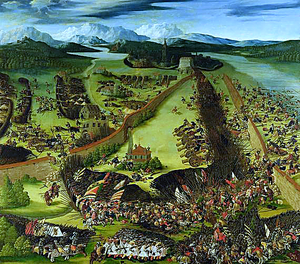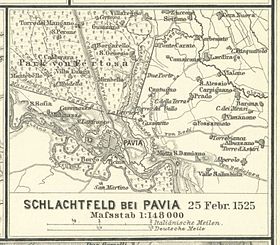Battle of Pavia (1525)
| date | 23. bis 24. February 1525 |
|---|---|
| place | Pavia in Lombardy |
| output | Decisive Habsburg victory |
| Parties to the conflict | |
|---|---|
| Commander | |
|
Fernando Francesco d'Avalos |
|
| Troop strength | |
| 26,000 mercenaries ( French , Italian and Confederates ) | 23,000 men, mostly Germans and Spaniards |
| losses | |
|
approx. 12,000 dead, 9,000 wounded or captured |
4,000–5,000 dead, as many wounded |
The Battle of Pavia was a battle in the context of the Italian wars for hegemony in Europe between the Habsburgs ( Spain - Burgundy - hereditary lands ) under Charles V and the Valois ( France ) under Francis I , which took place on February 24, 1525.
prehistory
The Italian Wars began in 1494 when Charles VIII of France tried to take control of Italy . He was pushed back by the Spanish-Austrian League, which England and the Italian states also joined. Charles's successor Ludwig XII. renewed the attack and occupied Milan in 1500 ; at the same time, with Naples, southern Italy fell to Spain in 1504. Ludwig's opponent in Germany was the Habsburg Maximilian I , who allied himself with the English King Henry VIII , so that Ludwig had to evacuate Milan after the battles of Guinegate and Novara (1513), which were costly for him .
Ludwig's successor Franz I was more successful at first, who won the brilliant victory at Marignano at the beginning of his rule in 1515 and took possession of Milan again. This was initially recognized by Spain in the Treaty of Noyon in 1516 , but a completely new situation arose with the election of Charles V in 1519 (Francis I had run against him himself), as this was to unite Spain, the Habsburg lands and the Reichs led in personal union and so France suddenly faced an opponent who could encompass the country on two sides and also have enormous resources from the newly discovered colonial areas. Charles V immediately declared the Noyon agreements null and void and the Italian wars entered a new phase after Charles had to deal with the outbreak of the Reformation in Germany at the Diet in Worms in 1521 , with his departure for Italy.
Siege and battle
In 1525 Francis I managed to forge an alliance with the Papal States, which felt threatened by the prospect of being clasped in the north and south of Habsburg. To support Pope Clement VII , Francis I came with an army of 26,000 mercenaries - among them French, Italian and Swiss - across the Alps and triumphantly entered Milan. A little later, Franz put a siege ring around the strategically important old Lombard residence of Pavia , which was held by a 6,000-strong garrison. To relieve them, Charles sent an army of 23,000 men under the Marquese of Pescara , who began the attack on the night of February 23. In the morning hours of the 24th (by the way, the 25th birthday of Charles V) it initially looked like a victory for the troops led by Admiral Bonnivet, but the Imperial troops, with 1,500 Basque arquebuses, managed a surprising attack on the center of the French lines whose king found. In an attempt to save Francis I, numerous high-ranking military leaders were killed, such as the Duke of La Tremouille and the Maréchal de Foix . The king's horse was also hit, so that Franz ultimately had to surrender to a Spanish nobleman. By this time the French army was almost completely wiped out or on the run.
Effects
Pescara brought the French king to the emperor in Madrid , where Francis I was treated with respect, but in order to be released he had to conclude the Treaty of Madrid in 1526 , which granted Charles the possession of Milan, Genoa, the Duchy of Burgundy and Naples. Released again, Francis I immediately revoked the peace, which he declared to have been enforced, thus nullifying the advantages Charles had gained. The struggle for supremacy in Europe would last until 1559, when Henry II concluded the Peace of Cateau-Cambrésis and so European supremacy passed from France to Spain.
Web links
- The Battle of Pavia (Italian) ( Memento of February 13, 2009 in the Internet Archive )
- Hans Stadler: Pavia, battle with. In: Historical Lexicon of Switzerland .
literature
- Rainer Brüning: The reporting of the battle of Pavia (1525), the Sacco di Roma (1527) and the siege of Vienna (1529) in contemporary pamphlets . Master's thesis, University of Hamburg 1987. (published?)
- Lucille K. Delano: Charles de Lannoy. Victor of Pavia . Christopher Publication House, Norwell, MA 1984, ISBN 0-8158-0442-3 .
- Luigi Casali, Marco Galandra: La battaglia di Pavia: February 24th, 1525. Iuculano, Pavia 1984.
- Jean Giono : Le Désastre de Pavie: 24 Février 1525 (Trente journées qui ont fait la France). Gallimard, Paris 1977.
- Konrad Häbler: The Battle of Pavia. In: Research on German History. Volume 25 (1885), Reprint-Verlag, Osnabrück 1968, pp. 511-525.
- Ernst Hinrichs: Small history of France . Reclam, Ditzingen 2006, ISBN 3-15-010596-X .
- Michael Mayr: On the criticism of contemporary sources on the Battle of Pavia in 1525. In: Görres Society for the Care of Science in Catholic Germany (Ed.): Festschrift Georg von Hertling on the seventieth birthday on August 31, 1913 . Kösel, Kempten 1913, pp. 329–336.
- Hans Stöcklein : The "Battle of Pavia" by Ruprecht Heller . In: Ernst Buchner , Karl Feuchtmayr (Ed.): Upper German art of the late Gothic and the Reformation period (= contributions to the history of German art . Vol. 1). Dr. B. Filser, Augsburg 1924, pp. 230-239.
- Reinhard Thom: The Battle of Pavia February 24, 1525 . Dissertation, University of Berlin 1907.
- Wilhelm Vogt: War and victory reports from the battle of Pavia, on February 24, 1525. In: Anzeiger für Kunde der Deutschen Vorzeit. Volume 24 (1877), Col. 328-332.
- Timothy Wilson (Ed.): The Battle of Pavia . Ashmolean Museum, Oxford 2003, ISBN 1-85444-186-8 .
- Hans Delbrück : History of the Art of War. The modern age . Nikol, Hamburg 2003, ISBN 3-933203-76-7 (reprint of the first edition from 1920).
Individual evidence
- ↑ See: Emil von Borries: About Franz 'I. Capture on February 24, 1525. In: Zeitschrift für Geschichtswwissenschaft. Volume 6, 1891.


